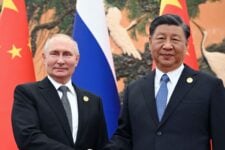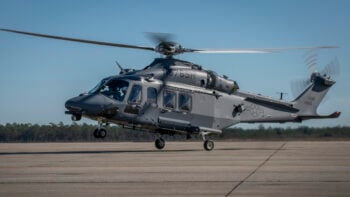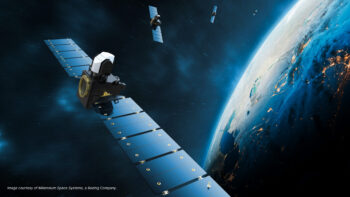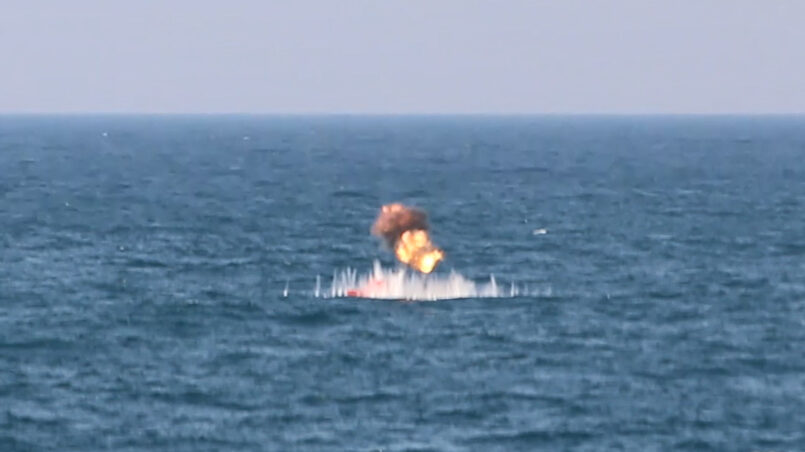
In this screen grab from video, munitions launched from a Lethal Miniature Aerial Missile System destroys a training target in the Arabian Gulf during Exercise Digital Talon, Oct. 23, 2023. (Photo by U.S. Navy)
BEIRUT — For the first time in the Middle East, the US Navy said it fired live munitions from unmanned surface vessels (USVs) during an exercise in the Gulf, part of a signal to potential regional adversaries amid the fighting in Gaza.
US Naval Forces Central Command (NAVCENT) said Thursday the live fires took place on October 23 as part of Exercise Digital Talon.
“NAVCENT’s priorities are deterrence and de-escalation. The exercise demonstrates the U.S. Navy’s ability to do both while enhancing maritime security and regional stability,” Cmdr. Rick Chernitzer, US 5th Fleet spokesman, told Breaking Defense.
According to NAVCENT’s announcement, the fleet’s Task Force 59, which is the first unmanned task force, “demonstrated the ability of unmanned platforms to pair with traditionally crewed ships in ‘manned-unmanned teaming’ to identify and target simulated hostile forces at sea. The hostile forces were represented through the use of a target boat. Then, using live munitions launched from another unmanned platform, NAVCENT forces engaged and destroyed the targets.”
Lethal Miniature Aerial Missile System on board of MARTAC T38 Devil Ray USV (unmanned surface vessel) succeeded in scoring multiple direct hits, while “a human operator ashore at Task Force 59’s Robotics Operations Center made the engagement decisions,” according to the statement.
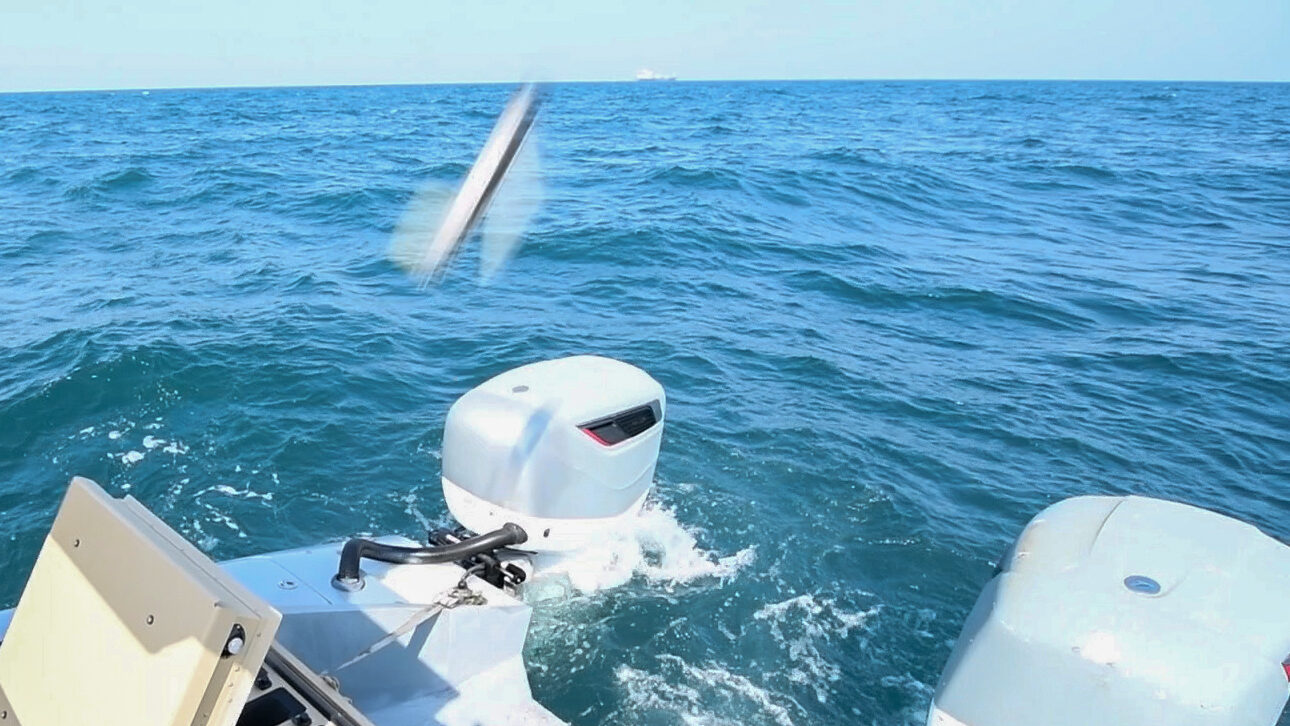
A Lethal Miniature Aerial Missile System launches munitions from a MARTAC T-38 Devil Ray unmanned surface vehicle, attached to U.S. Naval Forces Central Command’s Task Force 59, during Exercise Digital Talon in the Arabian Gulf, Oct. 23, 2023. (Photo by Chief Mass Communication Specialist Justin Stumberg)
“It is plausible that the US could have anticipated the decision to test lethal munitions as a strategy to signal to Iran and the Tehran-backed region-wide network of armed militias Washington’s steadfastness to counter malign activities of the Resistance Axis,” Leonardo Jacopo Maria Mazzucco, an independent researcher on the security affairs of the Gulf region and an analyst at Gulf State Analytics said.
Fifth Fleet touted its recent work surveilling potential threats in the Gulf, but said the exercise was meant to show more advanced capabilities. In September, NAVCENT unmanned vehicles — underwater, surface and aerial — tracked navy Iranian navy ships and boats during their patrol in Hormuz Strait. Last month, the 5th Fleet announced integrating successfully 12 unmanned systems increasing its manned-unmanned teaming in the Strait of Hurmuz into routine fleet operations.
“During Digital Talon, we took a significant step forward and advanced our capability to the ‘next level’ beyond just maritime domain awareness, which has been a traditional focus with Task Force 59. We have proven these unmanned platforms can enhance fleet lethality. In doing so, we are strengthening regional maritime security and enhancing deterrence against malign activity,” said NAVCENT Cmdr. Vice Adm. Brad Cooper in a statement.
Cooper expected an expansion in the scale and impact “including future exercises expanding the arsenal of combat-capable unmanned systems.”
Mazzucco told Breaking Defense that since Task Force 59’s launch it has held several naval drills (New Horizon, Digital Horizon, IMX) in NAVCENT’s area of operations to improve manned-unmanned interoperability.
“At-sea exercises have primarily focused on maritime domain awareness (MDA) duties by conducting high-speed maneuvers in formation or testing the intelligence, surveillance, and reconnaissance (ISR) capabilities of the USVs in real-world operational scenarios,” Mazzucco said. “While an absolute first for Washington’s USVs in Middle Eastern waters, the testing of lethal munitions from a MARTAC T38 Devil Ray USV represents the natural development of Task Force 59’s original mandate.”
He added that NAVCENT’s decision to step up the game on USVs and to expand the contribution of unmanned assets to the fleet’s daily tasks from non-kinetic to kinetic naval operations speaks volumes about two main elements: “first, NAVCENT’s growing confidence in the mission execution capabilities of unmanned platforms; second, a regional insecurity-driven pressing need to hasten a comprehensive integration of USVs in the 5th Fleet’s full-spectrum operations”
Ever since Hamas’s deadly attack on Israel on Oct. 7, and throughout Israel’s ferocious response, the US military has steamed forces into the region, including two aircraft carriers, in an effort to convince Iran and Iran-backed adversaries in the region to stay out of the conflict.
For instance, “with an operating hub in Aqaba, Jordan, the unmanned platforms of Task Force 59 could play a pivotal role in enhancing NAVCENT’s early detection capabilities vis-à-vis air threats originating from Houthi-controlled areas in northern Yemen,” Mazzucco concluded.
Is State Dept.’s AUKUS trade certification delay a sign of choppy waters ahead?
Ann McDonnell, chief operating officer for Export Controls Australia Group, told Breaking Defense, “I think definitely from the Australian perspective, it really seemed like we had done everything possible that we could do in a really quick timeframe to get that certification.”


